You can use different metrics to measure your marketing campaign’s performance. In email marketing, cost per result (CPR) is one of the most critical metrics. But what is it, and how do you calculate it?
CPR in email marketing refers to the amount you spend to get one result from your campaign. A result can be a click, sign up, purchase, download, or any other activity from your target audience. The metric ensures maximum returns for your investment and prevents losses.
Whether you are a start-up or an established business, it is essential to understand how cost per result works. Let’s look at the metrics in detail to help you make informed email marketing decisions.
How to Calculate CPR?
As the name suggests, cost per result is calculated by dividing the amount you spend in a campaign by the number of results you get.
CPR = Total Amount Spent ÷ Number of Results
To get the cost per result, it is essential to define the campaign’s objective. The most common results include the following:
- Purchase of a product or service
- Signing up for a newsletter
- Contact information submission
- Clicking a link
- Downloading a PDF, book, or template
- Watching a video
The rule of thumb is that CPR should be less than the amount you get from the activity.
For example, you have a book that goes for $20. The amount you spend to convert a prospect through email marketing should be below $20.
It only adds up if you spend $25 to get a conversion while earning $20 from the campaign.
What Is a Good Cost Per Result?
After understanding the meaning, knowing what good CPR means is essential.
While there is no one-size-fits-all for this question, some factors can help you know whether your cost per result is good for business.
The average cost of Google ads ranges between $2 and $4 per click. But a click doesn’t mean a result. Therefore, you should determine how many clicks result in a desirable outcome.
Some industries, like automobiles and real estate, have a high CPR because the profit margins are usually high.
That said, the profit you expect from a result determines the amount you can spend to run your email adverts.

Why Should You Track CPR?
Any marketing campaign aims to get as many conversions while spending as little as possible.
While metrics like clicks, impressions, reach, and expenditure are good, they need to give a clearer picture of profitability. That is where CPR comes in.
1. Maximize ROI
The cost per result can help you identify loopholes to reduce costs and increase conversions. You can get these answers if you need to change the copy or adjust your email schedule.
You can use A/B testing to try out different versions of your email marketing. The test helps you identify the most profitable approach to maximize your return on investment.
The success of any marketing is hinged on ROI. You can replace the campaign if the CPR is higher than the earnings. This process helps eliminate any campaigns that may adversely affect your bottom line.
2. Compare Different Campaigns
Assume you ran a campaign one month ago, and the CPR was $2. Today, you set up another email advert, and the cost per result rises to $3.
Although you may still be making a profit from the second campaign, you may want to evaluate what you can borrow from the former advert.
You can use CPR to compare your email marketing performance and come up with the best template. The comparison also keeps your budget in check to avoid going overboard.
That said, you should never dispose of the data you obtain from your campaigns. This information comes in handy in decision-making.
CPR also helps you to know the most profitable keywords or audiences for your campaigns.
3. Avoid Making Losses
There is a feeling that comes with seeing you have received 1000 conversions. But only once you check the amount spent and the revenue generated.
No matter how many conversions you get from a campaign, it will be futile if the amount doesn’t cater to the expense. Unless you are running an offer, you should keep your expenses below the cost.
CPR is the ultimate metric in ensuring you don’t make losses while running email marketing campaigns.

Factors That Affect Cost Per Result
As earlier noted, CPR differs from one industry, campaign, or company, to another. But what causes the variances in the cost?
1. Audience (Industry)
One of the primary determinants of cost per result is the target audience. The price can be lower or higher if you target prospects in some geographical regions, industry, age, and income brackets.
For example, the amount you pay for real estate email marketing campaigns differs from for toys. Because of the premium nature of the real estate industry, the cost per result will be higher.
However, a high cost per result doesn’t necessarily mean you are making losses. A house deal could give a profit of $10000 or more.
Therefore, if you spend $50 for every result, you are still making a good amount. You should only compare CPR within the same industry because the variances can be significant.
2. Copy
Your creativity determines the success of a campaign. The use of convincing language increases conversions and reduces the cost per result.
Your email copy should use catchy language that resonates with your target audience. Using visuals like images and videos can improve the rate of conversion.
If you don’t trust your creativity, it is advisable to hire a copywriter. The amount you pay can significantly impact your CPR, thus increasing your profitability.
3. Schedule
When should you send your emails? Identifying the time and days when your target audience is most active can increase deliverability and conversion rate.
Most email marketing providers provide scheduling options. Therefore, you can send the email at a specific time.
You should also identify the most appropriate day to send your marketing emails. Midweek (Tuesday, Wednesday, and Thursday) tend to be the most appropriate time to send emails.
Therefore, your CPR is likely to be lower if you send the emails within these days. This is because they are likely to be delivered to a higher volume of prospects.
4. Ad Quality and Competition
If a certain keyword or industry is highly competitive, the CPR will be higher because of the demand. In such cases, you should aim to outdo competitors with high-value content.
The quality of the ad determines the amount you pay to appear at the top spots. When the quality is not good, you will pay more to appear at the top in email marketing.
Therefore, optimizing the advert to meet your prospects’ expectations can be a good start in lowering the cost per result.

Conclusion
The cost per result in email marketing is the amount you pay for an advert divided by the number of conversions.
You should track CPR because it maximizes your ROI, prevents losses, and helps compare the performance of different campaigns.
Factors such as your audience, copy quality, ad scheduling, and competition can affect CPR. You can keep your cost per result low by meeting your prospects’ quality expectations.
